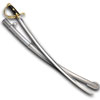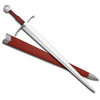|
|
|
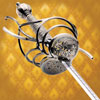 |
|
| The Christus Imperat Rapier Windlass |
Points: 20


|
A rapier of this identical form and proportions is currently housed in The Royal Armouries (formerly the Tower of London). The flamboyantly formed hilt is both beautiful and functional. Its' forward plates are pierced and show lavish birds among foliage, while the bars of the guard are slender both defending the hand and having an upward loop to catch an opponent’s blade.
|
|
|
|
|
|
 |
|
| Windlass Musketeer Rapier Sword 1590 |
Points: 20


|
Our Musketeer rapier is fashioned after those circa 1590. The basket hilt is ambidextrous and a very effective mix of both the cup-hilt and swept-hilt styles. The grip is wood wrapped with twisted wire and the parts of the hilt are plated with gleaming nickel silver.
|
|
|
|
|
|
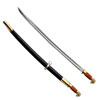 |
|
| Windlass Russian Shasqua |
Points: 12


|
Known originally as a Cossack cavalry weapon, this Russian Shasqua was later adopted as the official officer’s sword of the Soviet Union. The single‐edged, moderately curved blade is forged from tempered high‐carbon steel for strength.
|
|
|
|
|
|
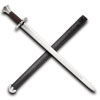 |
|
| Landsknecht Katzbalger Sword Windlass (501825) |
Points: 15


|
Our Landsknecht Katzbalger Sword is just as battle ready as the originals. The beautifully rendered grip would do any Landskecht proud. The fluting in the pommel extends seamlessly into the wood grip, and the guard is expertly spiral twisted and terminates in half-spheres.
|
|
|
|
|
|
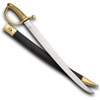 |
|
| Windlass French Napoleonic Briquet Short Sword (501867) |
Points: 10


|
This short saber was introduced in 1767, preceding the French Revolution, as a replacement for heavier and cumbersome swords like the fusilier’s ēpēe. It was instantly derided for its modest dimensions and nicknamed “Briquet” (”fire lighter”) and the name stuck and became official in 1806.
|
|
|
|
|
|
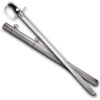 |
|
| Windlass British 1796 Heavy Cavalry Saber (501868s) |
Points: 10


|
The Austrian-designed British heavy cavalry sword of 1796 was used by British heavy cavalry units during the Napoleonic Wars. It was criticized for being unwieldy in combat, but was considered a powerful cutting weapon.
|
|
|
|
|
|
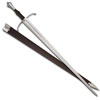 |
|
| Windlass Signature Series Towton Sword 1350-1400 (501893) |
Points: 15


|
In 1461, Edward IV led a Yorkist army against King Henry VI’s Lancastrians at Towton. A snowstorm favored the Yorkist archers, forcing 20,000 Lancastrians to charge downhill. Thousands died in one of England’s bloodiest battles. Named for that clash, our sword has a sharp, tapered blade, fine balance, and well-tempered steel.
|
|
|
|
|
|
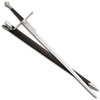 |
|
| Windlass Signature Series Sword of Roven 1400 (501895) |
Points: 12


|
This medieval sword has considerable length, providing both substantial reach and striking power. The Sword of Roven has a spring tempered, sharp blade made of 1075 high-carbon steel. The hilt features a wooden core with a cord wrap, finished in brown-black leather, while the guard and pommel are made of steel.
|
|
|
|
|
|
 |
|
| Windlass Persian Scimitar 1700 (501899s) |
Points: 10


|
The original scimitar was called a shamshir, (which meant "lion's tail") and had a deeply curved blade that was almost a half circle. Developed in Persia, this type of blade was effective for draw cuts, but other than that, of limited utility. This caused the blade to shift its shape into a more useful version, which we have chosen to copy.
|
|
|
|
|
|
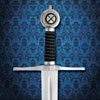 |
|
| Medieval Sword of Robert the Bruce (501495) |
Points: 10

|
Medieval Sword of Robert the Bruce. Inspired by the King of the Scots, Robert the Bruce, this sword has the Cross of St. Andrew set in the pommel. Hand forged 1065 high carbon steel comprises the blade. Overall: 43-1/2″ this sword dates circa 1300 and is made as seen in the film Robert the Bruce!
|
|
|
|
|
|
 |
|
| Ashdown Viking sword (501561) |
Points: 10

|
Ashdown Viking sword. The cross guard is richly decorated with raised knots. Both the guard and the head are made of steel and have been darkened to give an antique finish. Soft leather covers the wooden handle. The set includes a leather scabbard with a matching belt, which has a very decorative metal fitting.
|
|
|
|
|
|
 |
|
| Hanwei Saxon Sword 9th century (SH2436) |
Points: 25

|
CAS Hanwei’s smiths have outdone themselves with their recreation of a 9th Century Saxon sword by replicating a technique used by the Saxons and Vikings and producing a stunning blade that features a pattern-welded core with high-carbon edge sections. This technique was used by the old-time smiths as a means of producing blades (just for the rich folks) that were sharp, resilient and decorative and, eleven hundred years on, CAS Hanwei has made them affordable.
The sword’s design is based on a 9th Century piece found in the bank of a stream in England in 1976 and now on display in the Yorkshire Museum.
|
|
|
|
|
|
|
|
Tags:
swords, swords, historical sword, historical swords, medieval sword, medieval swords, museum sword, museum swords, Godfred, viking, Saxon Scramasax, Sir William Marshall Sword, Roman Sword, Gladius, Edward III Sword, Hand-and-a-Half Sword, Scottish Claymore, Lowlander, Two-Handed Great Sword, Roman Dagger,
|





